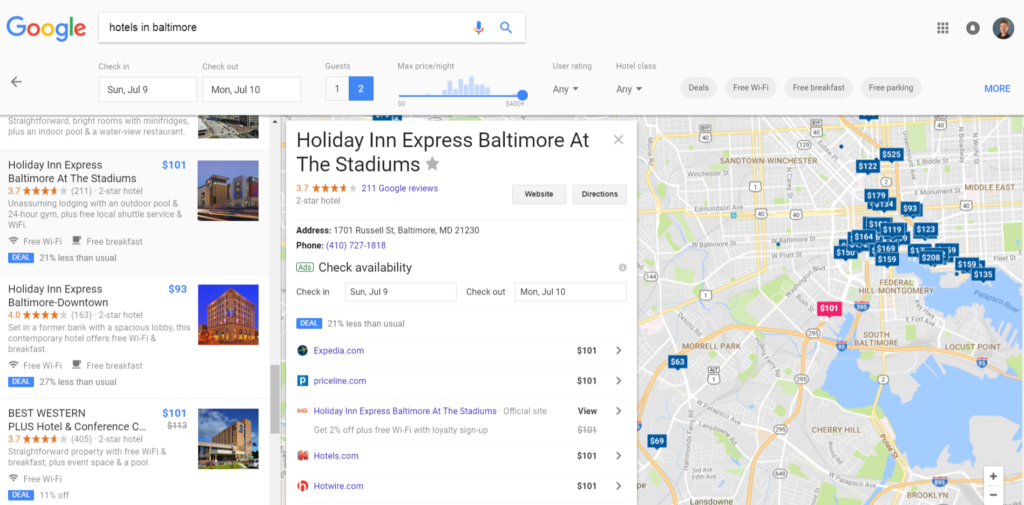Anyone who has done marketing within the hotel industry has had to contend with Online Travel Agencies, more commonly known as OTAs. For hoteliers they have been both a best friend and a worst enemy. If you are not familiar with the term, OTAs provide prospective guests with many hotels to choose from in whichever city they happen to be searching for. Some of the world’s most famous examples include Expedia, Booking.com, and Priceline.
The determining factor of a hotel’s relationship with OTAs is if the benefits of your listing outweighs the cost of it. On one hand these listings are sending potential guests to your property whenever you have available rooms, in some cases at the very last minute, allowing less of your inventory to go to waste. However, every room sold through an OTA rather than via your hotel’s website means you will lose a percentage of that revenue from commissions. Could you have attracted those guests without the help of OTAs? Are you being exposed to a market of guests you would never have reached?
The Billboard Effect
One of the leading examples of the value for OTAs is known as “The Billboard Effect,” in short, The Billboard Effect is a positive correlation between hotels that have managed OTA listings and organic bookings.
In 2009 Chris Anderson, a professor at Cornell University, conducted a study of a group of hotels. These hotels were removed from Expedia.com, and then brought back after a certain amount of time had passed. The results of this study were that while the hotels were listed on Expedia they received anywhere between 9 and 26 more reservations organically. This suggests that while a hotel has listings on OTA sites, they are more likely to drive travelers to their own website to generate a reservation. This phenomenon is what became known as The Billboard Effect.
Studies have also been conducted by Cornell again in 2011 and as recently as April of 2017 and they support that The Billboard Effect is still a very real thing.
Not everyone in hospitality agrees with these conclusions about The Billboard Effect. In 2014 a study of 50,000 online travel shoppers indicated that searchers who discover a hotel via a third party travel site are more likely to reserve a room through that channel. An important factor to note when looking at Billboard Effect studies is the correlation does not necessarily mean causation. There is a positive relationship between OTA listings and organic bookings, but that does not necessarily mean the OTAs are directly causing those bookings.
The validity of The Billboard Effect is still a topic of fierce debate, regardless of whether or not OTA listings are the direct cause of an increase in organic traffic, there is enough data to support that managing them can be beneficial to your hotel.
A Brief Overview of OTAs
In recent years the online travel industry underwent a series of incredible changes. While there used to be many different companies and organizations targeting different markets they have now merged together to form a small number of large conglomerates and networks. For example, at their inception Expedia, Travelocity, and Orbitz were completely separate entities; today, they are all connected through Expedia Partner Network, where hotel data is inputted and formatted out to each individual site and all room inventory is shared. Meanwhile, Booking.com and Priceline share select information and inventory about hotels; however, their descriptions are all custom written by their own team of writers and editors.
Meanwhile, Tripadvisor started out by simply serving up reviews of hotels. Now they have expanded out to what is known as meta search, which allows them to look for your room inventory across several sites and showcase to prospective guests the one with the best rates. Google has even developed this functionality and if you run a hotel related search in Google Maps, you will be able to see an approximate rate as well as what rates are available on different sites. It is because of these changes that maintaining rate parity has become more important than ever, if one site can provide significantly lower rates, they are more likely to dominate the reservation game.

An interesting side effect of the growth of OTAs is the pushback hotel brands have been giving. Over the past few years large scale brands have been implementing massive ad campaigns encouraging online travelers to “stop clicking around” and promoting their own rewards programs where they are able to give guests lower rates and more benefits than an OTA site. The Hyatt brand has opted to take this even farther and are currently in negotiations that might result in their properties leaving Expedia’s network entirely.
With OTAs joining together into massive networks and hotel brands promoting direct bookings, it is impossible to give a generalized yes or no answer on what hoteliers should do because every situation is different. Some hotels may not see a lot of traffic to their website and need OTA sites to help promote them and drive reservations. Other hotels may be filling most of their capacity on their own, with OTAs taking commissions for services they are not needed for. If you look carefully at your revenue data you can determine if multiple OTAs, or even just one in particular, is serving as a major revenue driver for your hotel. If you see a large amount of reservations directly, you will want to take a careful consideration of what The Billboard Effect might be doing for you, as it can be what is helping drive your traffic.
What Constitutes A “Good” OTA Listing
Since so many OTA sites share the same data, it has become more and more vital to keep that information accurate. If Expedia, for example, claims that you are pet friendly, then there is a very good chance that ten other travel sites are saying the same thing. These now send 11 signals of varying authority to different Google saying you are a pet friendly hotel. Even if you make a very clear disclaimer on your site that you are not, there is a likelihood Google will be telling searchers that you are because they have so many sources with data that says otherwise. Now you have guests showing up with their pets, furious that you are not pet friendly because the infallible Google said that you were!
Even if you do not want to provide inventory to major OTAs, it is still important to monitor and update your listings so that travelers that are conducting research are properly informed. They serve a purpose similar to local listing sites, meaning that you should make sure your name, address, and phone number are all correct. On top of that, pay attention to the amenities that will affect a visit to your hotel and make sure they are as correct as possible.
If you are not concerned with your marketability on OTAs then this is still important as a data signal. If OTAs provide a significant amount of bookings for your hotel this is even more important, because this is now a channel where guests will learn about your hotel and you want to sell them on your best features. If OTAs are a major source of revenue for your hotel, you will want to work with their representatives to provide them with ample inventory, this will be the best way to make sure guests can find you easily.
Most OTA sites do not allow you to make customized changes to your marketing text, which can sometimes be incredibly frustrating. Their algorithms copy and paste data into predetermined cells to keep things consistent on their end, much like the standards many hotel brands place upon their own websites. However, you can always reach out to OTAs to point out factually incorrect statements.
The Authority of Information on OTAs
When you explore your OTA listings to update them, consider the authority that each one has or the amount of reservations that you are likely to generate from them. Some websites carry much more authority than others, and the weight of what they say is determined by those signals. For example, if Expedia is sending a high volume of travelers to you that are under the impression you offer a free breakfast (and in this case you do not), this is a major problem that could negatively affect your reviews.They are an extremely popular travel site and Google is aware of this. The data that they send out is considered very trustworthy and the accuracy of information through it can affect many other listings as well as Google’s knowledge graph.
If TravelPanda.ru is telling potential guests your parking fee is one dollar more expensive than it actually is it might be a drop in the ocean of data signals that will not affect your results too much. Since this fictional example is not well known and does not have the same amount of trust, the effect that it has is relatively minor, to a point where it is not even noticeable. Your revenue data will also likely show if it is providing you with any revenue at all. In short, if a very minor, low authority site is providing guests with incorrect information, it is not as high a priority as a major travel site that is generating significant bookings.
Pro-tip: Explore your revenue reporting and see what OTAs are providing you with the most revenue, these are the ones you should make a priority. If you run a google search for your hotel you will likely see a result with a “knowledge graph” showing different details about your hotel. If there is an incorrect amenity on this you should explore the OTA listings that appear first to see where the issue resides.
A Picture is Worth A Thousand Words
What can truly make or break your success on OTAs is, without a doubt, the images that appear on your listings. Consider the fact that these photos are what can appear on a Google search for your hotel. The images a guest sees is their first impression of your hotel, and you want to make it a good one. Whenever your hotel undergoes a major renovation you should take new photography of the affected areas as soon as possible to provide an accurate depiction of how your property looks (after all, if a guest sees old photos on your OTA listing they may think you are an outdated property).
In terms of photography, your OTA listing should be treated similar to how you would treat an online dating profile. If you have a really good photo of yourself you would want to make sure potential matches can see it. Similarly, your guests are like those potential matches, and you want to impress them with the cool and unique things that make your hotel special. So, just like how you might take a photo with your dog to put on your Tinder profile to show how much of an animal lover you are, you would want to showcase your dog-friendly amenities in your OTA photos to make it clear that you are a pet-friendly hotel!
A best practice for your hotel photos is to always get the largest, highest quality version available. A branded hotel site will oftentimes have a required minimum and while OTAs are a little more flexible, the amount of photos and their sizes will reflect your “quality score” with them.
Note: If you happen to see old photos on a Google search this is not necessarily a bad thing. It often takes a few weeks for Google to crawl new images and make them appear above the ones it has been aware of for a while. So long as it is easy for a visitors to see the newer photos over the old ones you are doing fine.
Your quality score to a small degree will affect how visible you are through an OTA site. Hotels with low rates and high availability, few negative problems with guest experiences, and all their content filled out will be able to compete on Expedia and naturally gain a higher ranking. Naturally, these sites have their own algorithms designed to generate the most potential revenue, so hotels that gain a lot of reservations will oftentimes appear higher.
Gaining an Edge with Paid Search
If you truly want to generate more reservations through OTA listings, there are also paid opportunities that exist for the major players in the industry. Similar to a paid-search campaign, these opportunities allow you to bid for a top spot on listing sites. These will not guarantee you will always appear at the top of an OTA, nor will every visit result in a reservation. However, you will consistently be visible more often and you will regularly see a positive ROI from your efforts.
Gaining More Reservations Through OTA Sites
The next year will be very telling for the future of Online Travel Agencies. While many individual hotels rely on them to boost their revenue, there is a combative relationship between the large scale hotel brands and OTA sites. It is vital for you to consider your hotel’s unique situation and what revenue is coming from what OTA sites to help determine the time and energy you want directed into managing your listings.
If you are in a situation where managed OTA listings are beneficial to you, it is recommended that you carefully control your inventory into the sites that are providing you with revenue, and treat the information the same as a local listing, with highly accurate and consistent data to ensure the correct information is available. Always keep The Billboard Effect in mind, and know that your success on these listings can also lead to more organic reservations, and stay tuned for more news about the current status of this effect.
Likewise, since OTA listings count as an external signal to Search Engines about your hotel, you will want to make sure the amenity information is correct on as many high authority sites as possible. When you do this, it prevents users from finding incorrect information about your hotel.
Sometimes it can be difficult to get a full grasp of your most important OTA listings. They, as well as your other marketing channels might need the extra touch of experienced professionals. It is in these situations that I would recommend you get in touch to bring your marketing efforts to the next level.




